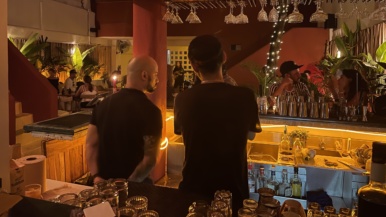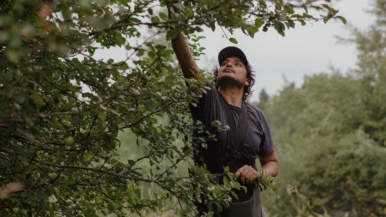The coolest job I ever had was being a Toronto Blue Jays mascot

When I arrived in Toronto 15 years ago, my plan was to wait tables and become an actor. Wide-eyed and fresh from New Brunswick, I knew maybe three people in the city. I discovered quickly that landing a restaurant job with zero experience was almost as hard as getting a meeting with an agent. Two months in, I was so broke I thought I’d have to move back home. At a government unemployment office, I saw a posting for a $12 an hour job as Pizza Pizza’s Dough Dude. I was an ideal candidate—I loved theatre, was a decent enough dance teacher all through my teens and had even been the Crime Stoppers Raccoon in a parade once, back in my tiny Maritime hometown, which seemed like a pretty big deal when I was 15. I got the job.
Dough Dude had huge silver sneakers and crazy orange hair. When I played him, he wore a mesh hockey shirt and his body was made from washable, flesh-coloured felt. His head was massive and he was perpetually smiling. So was I. As a mascot, you always smile when someone takes your picture, even though you eventually realize no one can see your face.
I played him as goofy but fly. People said “fly” back then. I thought of him as a guy who would really heat up the dance floor if you gave him a chance—kind of like Carlton Banks. I went to neighbourhood parties, air shows, store openings. Within a year, I would perform at almost every major event in Ontario, including Blue Jays, Raptors and Leafs games. In 2002, someone on the Jays’ operations team noticed me, and I was invited to understudy for Diamond, a flirty female mascot with a luscious blue ostrich-feather ponytail. Soon I was promoted to part-time mascot, sharing the role (and costume) with another woman. Then, right before the 2003 season opener, I was offered the job full-time. Or at least, I would be the only one playing Diamond; I was paid $100 a game, though Ace, the male mascot you still see on the field today, was a salaried employee.
My first day was in front of 50,000 cheering fans. Diamond had very pronounced, fully articulated eyelashes and a mechanical eye that would occasionally wink—I operated it with a button I held in my hand. Her comically oversized shoes had normal sneakers welded into them—I picked ones with some bounce, for jumps and splits. She had blue furry “feathers” on each hand, with loops for my fingers inside the costume. Most mascot newbies would have found the suit cumbersome and hot, but after three years as Dough Dude, Diamond was a cakewalk.
I relished the chance to play a girl. I got to be flirty, goofy, sassy and tough, and the fans ate it up. My all-time favourite move was doing the wave, letting it move back and forth through my arms while lowering my body gradually down into a full split with each pass. I would slink down further and further, holding my hand to my ear to encourage cheering. My dance training paid off as I bounced along the dugout’s metal roof. I’ll never forget how I would scrape the sides of my legs raw as I climbed up and down during the game, but with all the adrenalin, I wouldn’t feel it until later.

I’d never really cared about baseball before, but I became part of the team. Sometimes I would throw the first pitch when the Jays didn’t have anyone else to do it. I made a friend—a large man with a hearty laugh in a Jays uniform who would stand at the dugout entrance with me. He was an assistant to the team’s CEO. We used to play a little game where if I said Brad Pitt, he’d have to think of a celebrity whose name started with P, and so on. When we played it with baseball players, I would inevitably lose. Years later, I discovered my dugout pal was legendary Jays manager Cito Gaston.
It was a different team back then; there was no bat flipping, but there were some great players. Like the rest of the city, I fell in love with Carlos Delgado. He would flash a smile, high-five me and say “Hello Di-a-mond!,” stretching it out to three syllables. Second baseman Felipe López found me endlessly intriguing and would constantly knock on my big bird head. “What’s your name? You pretty? You pretty in there? I’m gonna call you.” He never tired of this routine. He also never called.
Lots of famous people visited the stadium, and I got to meet a few; I was featured in People magazine with Colin Farrell, and David Spade once joked on ESPN that I’d grabbed his ass. On Saturdays, I felt like the celebrity. Kids would be allowed on the field, and parents would clamour for autographs from Ace and me. Little girls would light right up meeting Diamond. They would hold Diamond dolls or sport temporary Diamond tattoos. I was proud to represent girls on the field. It was the thing that made me happiest.
The Jays decided to start phasing Diamond out near the end of the 2004 season. My last shift just happened to be on Dog Day, when people are allowed to bring their pets to the game—a day of stepping in shit. My heart was breaking knowing that Diamond would not be back next season. I wish I could have saved her. At the end of my final shift, dripping with sweat, I smiled as I peeled off my blue feathers for the last time and, with a wink of my mechanical eye, left the funnest job I ever had.
Amanda Barker is a comedian and actor. Email submissions to memoir@torontolife.com










